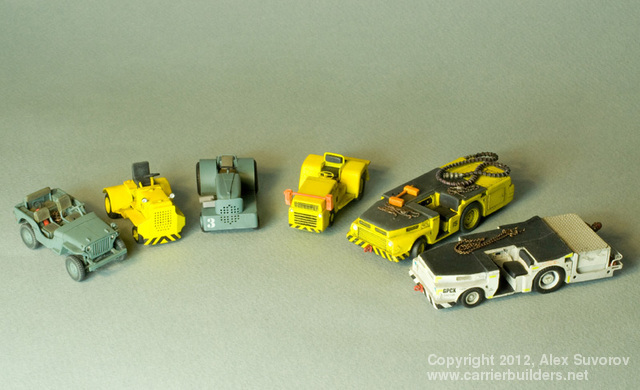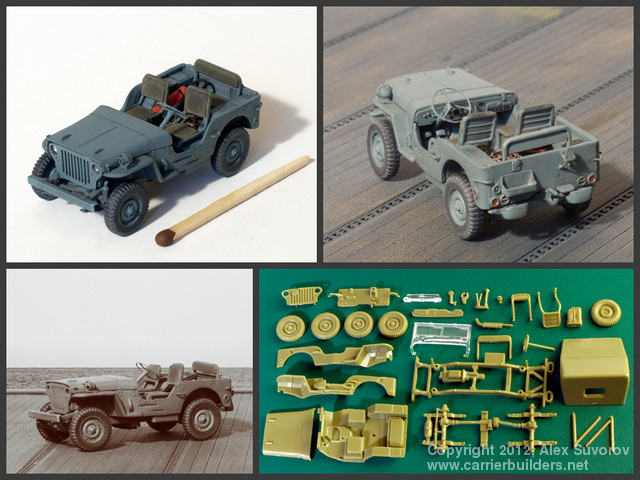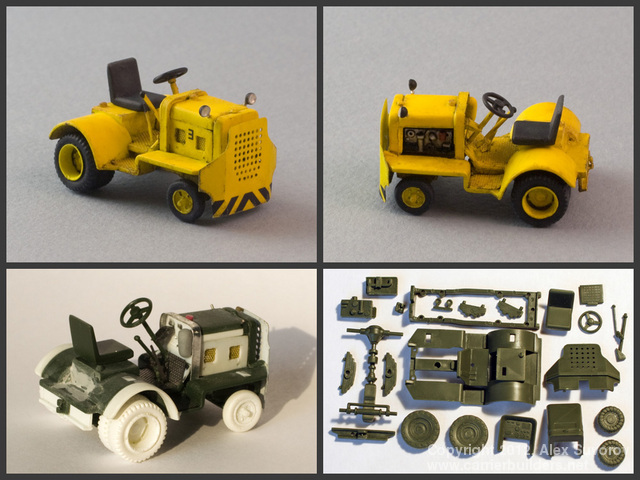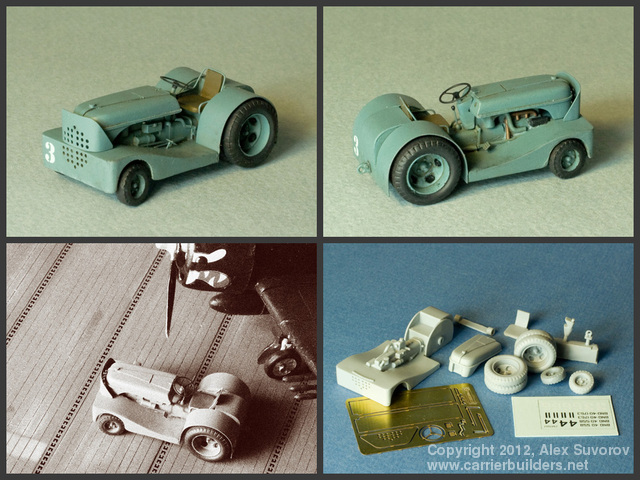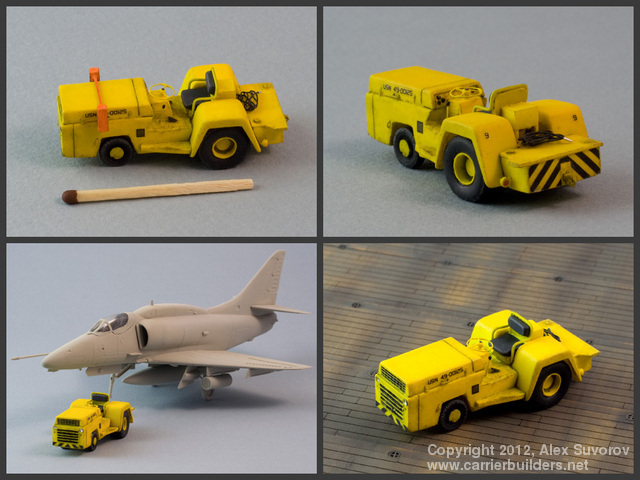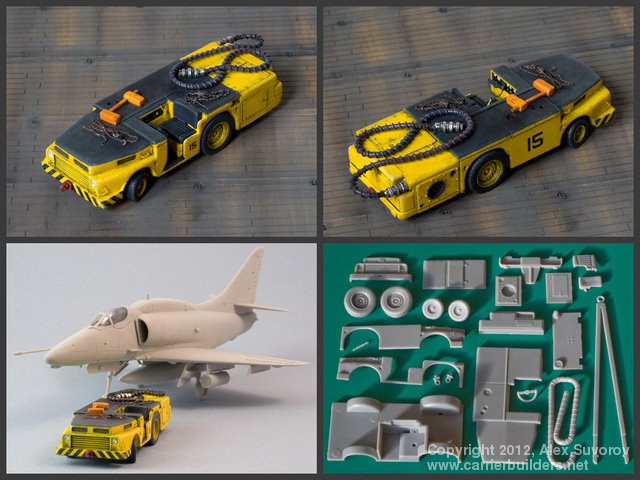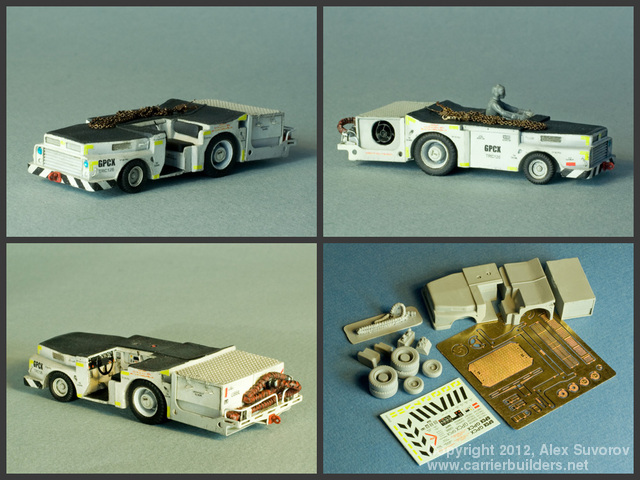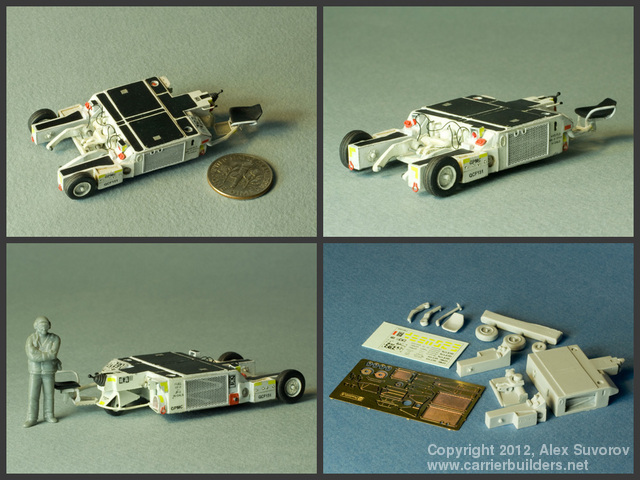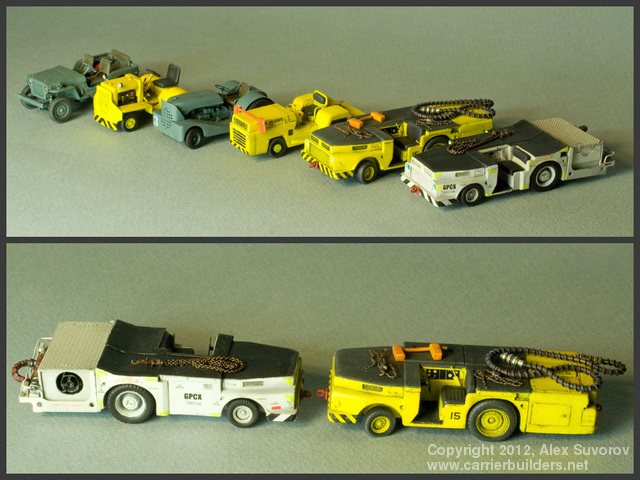AircraftProfilePrints.com - Museum Quality Custom Airctaft Profile Prints
For some years, I longed to have all types of the U.S. Navy's flight deck tractors in 1/72 scale so as to be able to compliment every type of the U.S. carrier aircraft model with a contemporary little tractor. And although my diorama projects are not complete yet, the issue of flight deck tractor models has quite recently become resolved. This article covers my models of all types of flight deck tractors that served on U.S. aircraft carriers.
Willys MB jeeps appeared on US Navy carrier decks in mid 1942. At this time Grumman Avenger torpedo-bomber was entering squadron service and it was much heavier than the mainstays of early wartime air groups, F4F Wildcat fighters and SBD Dauntless dive bombers. Thus the long established practice of manhandling aircraft around the deck began to negatively affect the efficiency of flight operations, which already increased dramatically when compared to the pre-war years and the first months of war. The logical choice was to have aircraft towed by tractor tugs, and Willys MB jeeps, together with Ford and Clark tractors, were acquired to serve in this role. Thus the Willys jeeps have faithfully served as aircraft tractors on fleet carriers (Yorktown and Essex classes) as well as on smaller ships (Independence, Bogue, Sangamon, Casablanca classes) till the end of the war. Afterwards, most shipboard jeeps were retired. For a short period of time some were retained for use as aircraft starters until replaced by purpose-built NC-1A vehicles in early 1950s. A number of Willys MB kits are available in 1/72 scale, offered by Academy, Airfix, Hasegawa and Italery. I believe that the set from Airfix, labeled "Willys Jeep and Trailer", contains the best jeep kit. Even when built out of the box, it will represent a real Willys more accurately. First of all, the wheels and the radiator grille – both very distinct features of this legendary vehicle – are the closest to the original in the Airfix rendition. Then, Airfix gives us a lot more interior and chassis details, although these are still too thick and rough for the scale. On the down side, the axe-and-shovel toolkit is molded together with the car's body, and the grille is marred by a round badge intended to carry a unit ID (not applicable for USN at all). I took the Airfix kit (cat. # 01322) and made the following improvements: - Details molded together with the jeep's body (braces, toolkit, etc.) were removed. - Instead, the following detailing was scratch-built and added: spare wheel and jerrycan empty holders, hood locks, steering wheel, gearbox levers, pedals. - Some scratch-built detailing was added to the chassis, including shock absorbers, leaf springs, exhaust system and the engine block. - Clear headlights with foil reflectors were installed.
The US Navy started to use Clark tractors on its aircraft carriers since mid 1942. The Clarktor 6 -model tractors, already in service on USAAF airfields at the time, helped to tow and position aircraft on the carriers' busy flight decks and saw success in this role. These vehicles were in use on Lexington, Essex and Midway class carriers. Replaced by newer flight deck tractors in mid 1950s, Clarktors continued to serve ashore on some Naval Air Stations until the late 1960s. The Clarktor 6 tractor model in 1/72 scale is available from Academy. It is a part of the set ("U.S. Ambulance & Tow Truck", cat. # 13403) which also includes a Dodge WC-45 ambulance and a rather generic bomb cart. The plastic is good, but the tractor's parts are rather crude and lack fine detailing. To build an accurate model one will have to replace the wheels and to correct the shape of the front grille, hood and rear fenders. An aftermarket photoetched detail set by Eduard is available for this kit. It allows to detail the driver's position rather nicely; however, the front grille supplied in the set is, unfortunately, inaccurate. My Clarktor model from the Academy's set was subject to the following improvements: - The tractor's body was corrected to accommodate twin rear wheels (as seen on most USN Clarktors); this included modifying the rear wheel wells and fenders. - The kit's wheels do not, even remotely, resemble the real thing. Therefore the new front and rear wheels were made using some stuff from a box of spares. - The kit's front grille was modified as neither the kit's original one nor the Eduard's are correct. - Dashboard and engine cowling's side panels made from scratch. - Aftermarket headlights with metal foil reflectors added (supplied by a company named Elf).
This type of flight deck tractor, based on a pre-war commercial model, entered service with the US Navy in 1943. These ubiquitous vehicles served on most USN carriers, including veterans like USS Enterprise (CV-6), Essex and Midway class attack carriers, Independence class light carriers and even the smaller Bogue, Sangamon, Casablanca and Commencement Bay class escort ships. After seeing through both the World War II and the Korean war they were replaced on US carriers by newer tractors in mid 1950s, while some went to work for the French Navy on the decks of R96 La Fayette (ex USS Langley) and R97 Bois Belleau (ex USS Belleau Wood). The 1/72 scale kit of the BNO-40 naval tractor is produced by F4Models (www.phantommodels.com, cat. # FM7007), and I've built it out-of-the-box. The fit is good, and the engine compartment is full of tiny details. One must take care when bending the photoetched part that represents the radiator grille so as to avoid making sharp edges.
In the 1950s, to keep pace with the growing weight of modern carrier jets, the US Navy faced a need to replace the aging flight deck tractors in use since the World War II. The new tractor for the Navy, the MD-1, has entered service in mid 1950s. Apart from the aircraft towing and positioning, MD-1s were employed to start up aircraft jet engines prior to takeoff. For this purpose many were fitted with gas turbine start units mounted on the platform in the rear; such tractors were informally known as "huffers". MD-1s have served on Essex / Oriskany, Midway and Forrestal / Kitty Hawk class carriers of the U.S. Navy until mid 1960s. A small number was also employed on the Royal Canadian Navy's HMCS Bonaventure. The 1:72 scale MD-1 kit (cat. # FM7001) was the very first model introduced by the F4Models company, and it shows. The moulds are, shall we say, of medium quality. However, through some filing and sanding, and by adding a couple of scratch-built details and wire braces and such, one can get a fairly nice little tractor to put along a Demon, a Skyray, a Fury, a Cougar or a Tiger, and even along an early Skyhawk or Skywarrior.
The MD-3 tractor appeared on the flight decks of the US Navy carriers in early 1960s. Being probably the first US purpose-built shipboard tractor, it was substantially larger and heavier than all its predecessors (to cope with towing heavier aircraft), but at the same time sported a very low profile so as to fit under the longer noses of modern aircraft. An interesting feature was the modular rear deck: different containers can be flush-mounted there, thus defining the vehicle's role. The jet aircraft start unit, housing a gas turbine air compressor, was the most common: nearly all MD-3s on carriers were equipped with one. A frame containing a compact firefighting unit could also be employed. The vehicle proved to be a success and came to serve on all US carriers (including Oriskany, Midway, Forrestal, Kitty Hawk, Enterprise and Nimitz classes) as well as on most helicopter carriers and assault ships (in particular, LPH Iwo Jima, LSD Anchorage / Whidbey Island / Harpers Ferry, LPD Austin, LHA Tarawa, LHD Wasp and LPD San Antonio). A small number was also employed on the Royal Canadian Navy's HMCS Bonaventure and on the Argentine Navy's carrier Veinticinco de Mayo. MD-3 models in 1/72 scale can be obtained from either Fujimi, Verlinden or a Chinese brand DreamModel. I have built mine from the Fujimi's "Flight Deck Crew & Carrier Tractor" set (cat. # 35001) which also includes ten flight deck personnel figures. The set contains the early (pre-1990s) version of the tractor and provides three options: one can build a tractor with either a compressor or a firefighting unit attached, or have it in a plain "tractor only" configuration. The MD-3 itself is rather accurate and well detailed; the only major issue is the rear wheels: they should have twin, not single, tires. I had the kit's rear wheels with single tires replaced with twin tires; this process included making wider wheel wells in the tractor's body and getting additional tires by replicating the original ones through casting. To detail the tractor further, I have added a number of small scratch-built items, including some braces, levers and pedals on the driver's position and clear headlights with metal foil reflectors. The compressor's air hose is also scratch-built, as the one supplied with the kit looks genuinely plastic. The tie-down chains came from the White Ensign Models photoetched set.
A/S-32A-31A is a current flight deck tractor for all active US Navy aircraft carriers and amphibious ships. On carriers the vehicle is typically equipped with a gas turbine unit to start jet aircraft engines. When compared to the older MD-3 tractor in service since the 1960s through the 1990s, the A/S-32A-31A has a different rear end and a new starter unit. The vehicles have served or are in service on Kitty Hawk, Enterprise and Nimitz class carriers as well as Whidbey Island, Harpers Ferry, Austin, Tarawa, Wasp and San Antonio class amphibious ships. Several tractors were obtained by the Indian Navy along with INS Jalashwa (ex USS Trenton). This is another kit from F4Models (cat. # FM7002). The resin parts are fairly good; however, assembling the starter unit, and especially the related photoetched parts, is not an easy task. Some sanding and filing and improvising is needed to achieve the correct fit. As usual, I scratch-built some braces and levers from thin wire. For headlights, I made reflectors from self-adhesive bare metal foil and then applied drops of clear blue paint. The tie-down chains in this case are made from real chain, supplied by a company named Verf' na stole (www.shipmodeling.ru); they look much more realistic than the photoetched ones, I must say. This concludes the history of the US Navy's flight deck tractors. There is a "bonus track", however: the Navy's standard hangar deck tractor.
In the early 1960s the US Navy ordered a purpose-built vehicle to tow, turn and position aircraft on hangar decks and elevators of its aircraft carriers. The new SD-2, known informally as "Spotting Dolly", was small and agile: it could fit under the fuselage of most aircraft and pivoted on a caster wheel with a zero turning radius. Its two hydraulically articulated arms pinned the aircraft nosewheel and allowed for precise positioning within the confines of hangars and elevators. In 1990s an updated version of the spotting dolly was introduced – the A/S32A-32A – that is still in use today on all U.S. carriers (Kitty Hawk, Enterprise and Nimitz class) and large-deck amphibious ships (Tarawa and Wasp class). The 1:72 kit of the A/S32A-32A version also comes from F4Models (cat. # FM7004), and again this is a practically out-of-the-box build. There are quite a lot of parts on the small photo etched fret, including very fine mesh screens. I have added some metal wire to model various hydraulic lines and the axle that moves the towing arms. For headlights, I made reflectors from self-adhesive bare metal foil and then applied drops of clear red paint. Those interested to read the full history of the U.S. Navy's flight deck tractors can look at my article on the subject published in the Military Aircraft Monthly magazine's May 2010 issue.
Photos and text © 2012 by Alex Suvorov October 4, 2012 |
